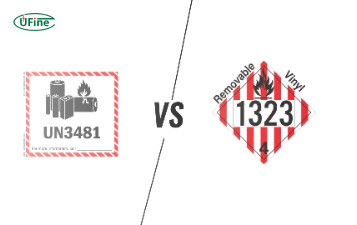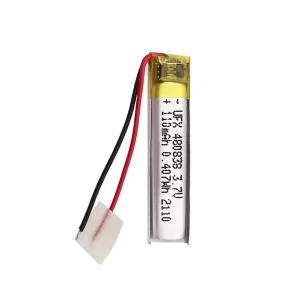Welcome to the best guide for 3.7V rechargeable lithium-ion batteries. This extensive look goes into why lithium-ion batteries work at 3.7V. It explains their stuff, where to use them, the picking process, and ways to charge.
Part 1. Why is the lithium-ion battery at 3.7V?
The 3.7V voltage is the main thing of lithium-ion stuff, where lithium is a crucial part of the electric reaction. This power level lets you store and use power well, so lithium-ion batteries are excellent for many small tech things like phones, laptops, and cameras. Also, the 3.7V power works with many new tech needs, so it works great and does the best.
Part 2. Understanding 3.7V rechargeable lithium-ion battery chemistries
Positive Electrode (Cathode)
- Comprised typically of lithium cobalt oxide (LiCoO2).
- Lithium ions move from the cathode to the anode, storing energy during charging.
- The cathode is critical in determining the battery’s voltage and energy density.
Negative Electrode (Anode)
- Usually constructed from graphite.
- It accepts the lithium ions during charging and releases them during discharging.
- The anode’s structure and material influence the battery’s capacity and performance.
Electrolyte
- A liquid or gel-like substance containing lithium ions.
- Facilitates the movement of ions between the cathode and anode during charging and discharging.
- The composition and stability of the electrolyte impact the battery’s safety and performance.
Separator
- A porous membrane that physically separates the cathode and anode.
- Prevents direct contact between the electrodes to avoid short circuits.
- It allows the passage of lithium ions while blocking the flow of electrons.
Electrochemical Reactions
- During charging, lithium ions move from the cathode to the anode through the electrolyte, storing energy. During discharging, the ions move back to the cathode, releasing energy.
Voltage
- The 3.7V voltage represents the average potential difference between the cathode and anode during the battery’s discharge cycle.
Variations
- While 3.7V is typical, variations exist based on cathode materials, such as lithium iron phosphate (LiFePO4) or lithium manganese oxide (LiMn2O4), which may have slightly different voltages.
Energy Density
- Lithium-ion batteries offer high energy density compared to other rechargeable batteries, making them suitable for portable electronic devices.
Safety Considerations
- Chemistries with higher voltages may have safety concerns, such as thermal runaway or reduced cycle life, hence the preference for 3.7V chemistry for consumer electronics.
Part 3. 3.7V Rechargeable lithium-ion battery applications
Consumer Electronics
- They are powering smartphones, laptops, tablets, and wearable devices due to their high energy density and lightweight design.
- They are used in digital cameras, camcorders, and portable gaming consoles for reliable and long-lasting performance.
Electric Vehicles (EVs) and Hybrid Vehicles
- We are providing the primary power source or as part of a hybrid system to store energy for propulsion.
- They are used in electric cars, electric bicycles, and scooters for emission-free transportation.
Power Tools
- Powering cordless drills, saws, and other power tools for convenient and portable operation on job sites or at home.
- Lithium-ion batteries offer high power output and long runtime, improving efficiency and productivity.
Medical Devices
- We power portable medical devices such as defibrillators, infusion pumps, and oxygen concentrators.
- Reliable energy storage and long cycle life make lithium-ion batteries ideal for critical medical applications.
Renewable Energy Storage
- We store energy generated from solar panels and wind turbines for later use.
- Lithium-ion batteries help stabilize renewable energy sources by providing a reliable backup power supply.
Aerospace and Defense
- They are used in satellites, spacecraft, and military equipment for their lightweight and high-energy density properties.
- Lithium-ion batteries provide essential power for communication, navigation, and surveillance systems.
Energy Storage Systems (ESS)
- They are used in grid-scale energy storage systems to store excess electricity during off-peak hours and release it during peak demand.
- Lithium-ion batteries support the integration of renewable energy sources into the electrical grid.
Part 4. How do you choose the right 3.7V rechargeable lithium-ion battery for your device?
Check Voltage Compatibility
- Verify that the battery’s nominal voltage of 3.7V matches the voltage requirements of your device. Using a battery with an incorrect voltage may damage your device or lead to malfunction.
Evaluate capacity (mAh)
- Assess the energy capacity required for your device’s intended usage pattern. Choose a battery with a capacity (mAh) that meets or exceeds your device’s power consumption needs to ensure sufficient runtime between charges.
Consider Physical Size and Form Factor
- Measure the available space within your device’s battery compartment to ensure compatibility with the battery’s physical dimensions.
- Select a battery with a suitable form factor (e.g., cylindrical, prismatic, or pouch) that fits snugly within the device without causing any bulging or interference with other components.
Chemistry and Performance
- Understand the differences between various lithium-ion battery chemistries (e.g., lithium cobalt oxide, lithium iron phosphate) in terms of energy density, cycle life, and temperature range.
- Choose a battery chemistry that aligns with your device’s power requirements and performance expectations, considering factors such as operating temperature and discharge rate.
Temperature Range
-
- The operating temperature range for a typical 3.7V rechargeable lithium-ion battery is typically between -20 °C and 60°C (- 4°F to 140°F).
- It’s important to note that extreme temperatures can affect the battery’s performance and lifespan.
Check Safety Features
-
-
-
- Prioritize batteries with built-in safety mechanisms, such as overcharge protection, over-discharge protection, and short circuit protection.
- Ensure that the battery complies with industry safety standards and certifications to mitigate the risk of fire, explosion, or other hazards.
-
-
Consider Brand Reputation and Quality
-
-
-
- Research reputable lithium-ion battery manufacturers known for producing high-quality and reliable products.
- Read customer reviews and testimonials to gauge the brand’s reputation for product performance, durability, and customer support.
-
-
Factor in Cost and Value
-
-
-
- Balance the upfront cost of the battery with its long-term value proposition, considering factors such as lifespan, warranty coverage, and overall performance.
- Avoid sacrificing quality or safety for a lower price, as inferior batteries may compromise your device’s functionality or pose safety risks.
-
-
Part 5. How to charge a 3.7V Rechargeable lithium-ion battery?
Use the Correct Charger
Ensure you use a charger specifically designed for lithium-ion batteries with an output voltage matching the battery’s 3.7V.
Check Charging Current
Determine the appropriate charging current based on the battery’s capacity to avoid overcharging and potential damage.
Monitor Charging Temperature
Charge the battery within the recommended temperature range, typically between 0°C and 45°C (32°F to 113°F), to prevent overheating.
Avoid Overcharging
Disconnect the battery from the charger once it reaches full charge to prevent overcharging, which can degrade battery life.
Use a Timer if Necessary
Consider using a timer to limit charging duration, especially if the charger doesn’t have automatic shut-off features.
Inspect Charger and Connections
Regularly check the charger and charging cable for any signs of damage or wear that could affect charging efficiency or safety.
Charge in a Safe Location
Charge the battery in a well-ventilated area away from flammable materials and direct sunlight to reduce the risk of fire or explosion.
Part 6. Conclusion
Understanding 3.7V Rechargeable Lithium Ion Battery chemistry, where they’re used, tips for choosing the right one for your device, and how to charge them effectively. With this guide, you’re all set to make the most of your 3.7V lithium-ion batteries in various devices and applications.
Related Tags:
More Articles

UN3481 vs UN1323: Classification Guide for Lithium Batteries
UN3481 vs UN1323: UN3481 is for lithium batteries in equipment, while UN1323 covers flammable solids and doesn't apply to batteries.
10000mAh Battery Explained: How Long It Lasts, How It Works
A full guide on 10000mAh li-ion batteries, voltage, usage time, and tips. Discover how a 10000mAh battery works, how long it lasts, and how to choose.
10440 Battery Guide: Size, Voltage, Capacity, Uses & More
Understand 10440 batteries better—size, voltage, safety, and how they compare to AAA. Find the best fit for your high-performance devices.
White Stuff on Battery Terminals: A Step-by-Step Cleaning and Maintenance Guide
White stuff on battery terminals is corrosion. Learn how to clean it safely, prevent damage, and keep your battery running strong with simple steps.
Understanding How Glass Mat Batteries Work: Technology, Benefits, and Limitations
Glass mat batteries power cars, RVs, and solar systems. Learn how they work, their benefits, and what to consider before choosing one.




